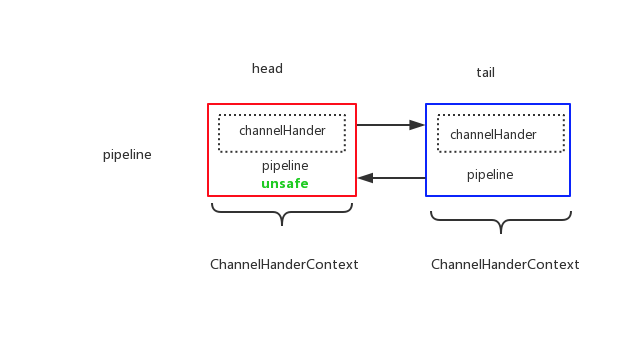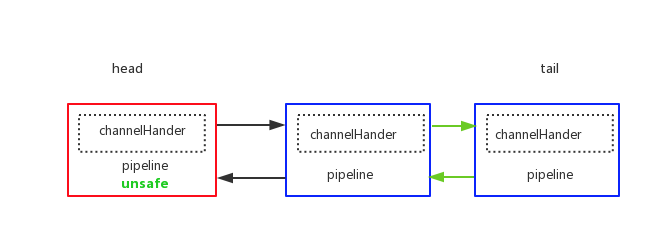Netty源碼分析 (四)—– ChannelPipeline
- 2019 年 10 月 3 日
- 筆記
netty在服務端埠綁定和新連接建立的過程中會建立相應的channel,而與channel的動作密切相關的是pipeline這個概念,pipeline像是可以看作是一條流水線,原始的原料(位元組流)進來,經過加工,最後輸出
pipeline 初始化
在上一篇文章中,我們已經知道了創建NioSocketChannel的時候會將netty的核心組件創建出來

pipeline是其中的一員,在下面這段程式碼中被創建
protected AbstractChannel(Channel parent) { this.parent = parent; id = newId(); unsafe = newUnsafe(); pipeline = newChannelPipeline(); }
protected DefaultChannelPipeline newChannelPipeline() { return new DefaultChannelPipeline(this); }
NioSocketChannel中保存了pipeline的引用
DefaultChannelPipeline
protected DefaultChannelPipeline(Channel channel) { this.channel = ObjectUtil.checkNotNull(channel, "channel"); tail = new TailContext(this); head = new HeadContext(this); head.next = tail; tail.prev = head; }
pipeline中保存了channel的引用,創建完pipeline之後,整個pipeline是這個樣子的

pipeline中的每個節點是一個ChannelHandlerContext對象,每個context節點保存了它包裹的執行器 ChannelHandler 執行操作所需要的上下文,其實就是pipeline,因為pipeline包含了channel的引用,可以拿到所有的context資訊
pipeline添加節點
下面是一段非常常見的客戶端程式碼
bootstrap.childHandler(new ChannelInitializer<SocketChannel>() { @Override public void initChannel(SocketChannel ch) throws Exception { ChannelPipeline p = ch.pipeline(); p.addLast(new Spliter()) p.addLast(new Decoder()); p.addLast(new BusinessHandler()) p.addLast(new Encoder()); } });
首先,用一個spliter將來源TCP數據包拆包,然後將拆出來的包進行decoder,傳入業務處理器BusinessHandler,業務處理完encoder,輸出
整個pipeline結構如下

我用兩種顏色區分了一下pipeline中兩種不同類型的節點,一個是 ChannelInboundHandler,處理inBound事件,最典型的就是讀取數據流,加工處理;還有一種類型的Handler是 ChannelOutboundHandler, 處理outBound事件,比如當調用writeAndFlush()類方法時,就會經過該種類型的handler
不管是哪種類型的handler,其外層對象 ChannelHandlerContext 之間都是通過雙向鏈表連接,而區分一個 ChannelHandlerContext到底是in還是out,在添加節點的時候我們就可以看到netty是怎麼處理的
DefaultChannelPipeline
@Override public final ChannelPipeline addLast(ChannelHandler... handlers) { return addLast(null, handlers); }
@Override public final ChannelPipeline addLast(EventExecutorGroup executor, ChannelHandler... handlers) { for (ChannelHandler h: handlers) { addLast(executor, null, h); } return this; }
public final ChannelPipeline addLast(EventExecutorGroup group, String name, ChannelHandler handler) { final AbstractChannelHandlerContext newCtx; synchronized (this) { // 1.檢查是否有重複handler checkMultiplicity(handler); // 2.創建節點 newCtx = newContext(group, filterName(name, handler), handler); // 3.添加節點 addLast0(newCtx); } // 4.回調用戶方法 callHandlerAdded0(handler); return this; }
這裡簡單地用synchronized方法是為了防止多執行緒並發操作pipeline底層的雙向鏈表
我們還是逐步分析上面這段程式碼
檢查是否有重複handler
在用戶程式碼添加一條handler的時候,首先會查看該handler有沒有添加過
private static void checkMultiplicity(ChannelHandler handler) { if (handler instanceof ChannelHandlerAdapter) { ChannelHandlerAdapter h = (ChannelHandlerAdapter) handler; if (!h.isSharable() && h.added) { throw new ChannelPipelineException( h.getClass().getName() + " is not a @Sharable handler, so can't be added or removed multiple times."); } h.added = true; } }
netty使用一個成員變數added標識一個channel是否已經添加,上面這段程式碼很簡單,如果當前要添加的Handler是非共享的,並且已經添加過,那就拋出異常,否則,標識該handler已經添加
由此可見,一個Handler如果是sharable的,就可以無限次被添加到pipeline中,我們客戶端程式碼如果要讓一個Handler被共用,只需要加一個@Sharable標註即可,如下
@Sharable public class BusinessHandler { }
而如果Handler是sharable的,一般就通過spring的注入的方式使用,不需要每次都new 一個
isSharable() 方法正是通過該Handler對應的類是否標註@Sharable來實現的
ChannelHandlerAdapter
public boolean isSharable() { Class<?> clazz = getClass(); Map<Class<?>, Boolean> cache = InternalThreadLocalMap.get().handlerSharableCache(); Boolean sharable = cache.get(clazz); if (sharable == null) { sharable = clazz.isAnnotationPresent(Sharable.class); cache.put(clazz, sharable); } return sharable; }
通過反射判斷是否有Sharable.class註解
創建節點
回到主流程,看創建上下文這段程式碼
newCtx = newContext(group, filterName(name, handler), handler);
這裡我們需要先分析 filterName(name, handler) 這段程式碼,這個函數用於給handler創建一個唯一性的名字
private String filterName(String name, ChannelHandler handler) { if (name == null) { return generateName(handler); } checkDuplicateName(name); return name; }
顯然,我們傳入的name為null,netty就給我們生成一個默認的name,否則,檢查是否有重名,檢查通過的話就返回
netty創建默認name的規則為 簡單類名#0,下面我們來看些具體是怎麼實現的
private static final FastThreadLocal<Map<Class<?>, String>> nameCaches = new FastThreadLocal<Map<Class<?>, String>>() { @Override protected Map<Class<?>, String> initialValue() throws Exception { return new WeakHashMap<Class<?>, String>(); } }; private String generateName(ChannelHandler handler) { // 先查看快取中是否有生成過默認name Map<Class<?>, String> cache = nameCaches.get(); Class<?> handlerType = handler.getClass(); String name = cache.get(handlerType); // 沒有生成過,就生成一個默認name,加入快取 if (name == null) { name = generateName0(handlerType); cache.put(handlerType, name); } // 生成完了,還要看默認name有沒有衝突 if (context0(name) != null) { String baseName = name.substring(0, name.length() - 1); for (int i = 1;; i ++) { String newName = baseName + i; if (context0(newName) == null) { name = newName; break; } } } return name; }
netty使用一個 FastThreadLocal(後面的文章會細說)變數來快取Handler的類和默認名稱的映射關係,在生成name的時候,首先查看快取中有沒有生成過默認name(簡單類名#0),如果沒有生成,就調用generateName0()生成默認name,然後加入快取
接下來還需要檢查name是否和已有的name有衝突,調用context0(),查找pipeline裡面有沒有對應的context
private AbstractChannelHandlerContext context0(String name) { AbstractChannelHandlerContext context = head.next; while (context != tail) { if (context.name().equals(name)) { return context; } context = context.next; } return null; }
context0()方法鏈表遍歷每一個 ChannelHandlerContext,只要發現某個context的名字與待添加的name相同,就返回該context,最後拋出異常,可以看到,這個其實是一個線性搜索的過程
如果context0(name) != null 成立,說明現有的context裡面已經有了一個默認name,那麼就從 簡單類名#1 往上一直找,直到找到一個唯一的name,比如簡單類名#3
如果用戶程式碼在添加Handler的時候指定了一個name,那麼要做到事僅僅為檢查一下是否有重複
private void checkDuplicateName(String name) { if (context0(name) != null) { throw new IllegalArgumentException("Duplicate handler name: " + name); } }
處理完name之後,就進入到創建context的過程,由前面的調用鏈得知,group為null,因此childExecutor(group)也返回null
DefaultChannelPipeline
private AbstractChannelHandlerContext newContext(EventExecutorGroup group, String name, ChannelHandler handler) { return new DefaultChannelHandlerContext(this, childExecutor(group), name, handler); } private EventExecutor childExecutor(EventExecutorGroup group) { if (group == null) { return null; } //.. }
DefaultChannelHandlerContext
DefaultChannelHandlerContext( DefaultChannelPipeline pipeline, EventExecutor executor, String name, ChannelHandler handler) { super(pipeline, executor, name, isInbound(handler), isOutbound(handler)); if (handler == null) { throw new NullPointerException("handler"); } this.handler = handler; }
構造函數中,DefaultChannelHandlerContext將參數回傳到父類,保存Handler的引用,進入到其父類
AbstractChannelHandlerContext
AbstractChannelHandlerContext(DefaultChannelPipeline pipeline, EventExecutor executor, String name, boolean inbound, boolean outbound) { this.name = ObjectUtil.checkNotNull(name, "name"); this.pipeline = pipeline; this.executor = executor; this.inbound = inbound; this.outbound = outbound; }
netty中用兩個欄位來表示這個channelHandlerContext屬於inBound還是outBound,或者兩者都是,兩個boolean是通過下面兩個小函數來判斷(見上面一段程式碼)
DefaultChannelHandlerContext
private static boolean isInbound(ChannelHandler handler) { return handler instanceof ChannelInboundHandler; } private static boolean isOutbound(ChannelHandler handler) { return handler instanceof ChannelOutboundHandler; }
通過instanceof關鍵字根據介面類型來判斷,因此,如果一個Handler實現了兩類介面,那麼他既是一個inBound類型的Handler,又是一個outBound類型的Handler,比如下面這個類

常用的,將decode操作和encode操作合併到一起的codec,一般會繼承 MessageToMessageCodec,而MessageToMessageCodec就是繼承ChannelDuplexHandler
MessageToMessageCodec
public abstract class MessageToMessageCodec<INBOUND_IN, OUTBOUND_IN> extends ChannelDuplexHandler { protected abstract void encode(ChannelHandlerContext ctx, OUTBOUND_IN msg, List<Object> out) throws Exception; protected abstract void decode(ChannelHandlerContext ctx, INBOUND_IN msg, List<Object> out) throws Exception; }
context 創建完了之後,接下來終於要將創建完畢的context加入到pipeline中去了
添加節點
private void addLast0(AbstractChannelHandlerContext newCtx) { AbstractChannelHandlerContext prev = tail.prev; newCtx.prev = prev; // 1 newCtx.next = tail; // 2 prev.next = newCtx; // 3 tail.prev = newCtx; // 4 }
用下面這幅圖可見簡單的表示這段過程,說白了,其實就是一個雙向鏈表的插入操作

操作完畢,該context就加入到pipeline中

到這裡,pipeline添加節點的操作就完成了,你可以根據此思路掌握所有的addxxx()系列方法
回調用戶方法
AbstractChannelHandlerContext
private void callHandlerAdded0(final AbstractChannelHandlerContext ctx) { ctx.handler().handlerAdded(ctx); ctx.setAddComplete(); }
到了第四步,pipeline中的新節點添加完成,於是便開始回調用戶程式碼 ctx.handler().handlerAdded(ctx);,常見的用戶程式碼如下
public class DemoHandler extends SimpleChannelInboundHandler<...> { @Override public void handlerAdded(ChannelHandlerContext ctx) throws Exception { // 節點被添加完畢之後回調到此 // do something } }
接下來,設置該節點的狀態
AbstractChannelHandlerContext
final void setAddComplete() { for (;;) { int oldState = handlerState; if (oldState == REMOVE_COMPLETE || HANDLER_STATE_UPDATER.compareAndSet(this, oldState, ADD_COMPLETE)) { return; } } }
用cas修改節點的狀態至:REMOVE_COMPLETE(說明該節點已經被移除) 或者 ADD_COMPLETE
pipeline刪除節點
netty 有個最大的特性之一就是Handler可插拔,做到動態編織pipeline,比如在首次建立連接的時候,需要通過進行許可權認證,在認證通過之後,就可以將此context移除,下次pipeline在傳播事件的時候就就不會調用到許可權認證處理器
下面是許可權認證Handler最簡單的實現,第一個數據包傳來的是認證資訊,如果校驗通過,就刪除此Handler,否則,直接關閉連接
public class AuthHandler extends SimpleChannelInboundHandler<ByteBuf> { @Override protected void channelRead0(ChannelHandlerContext ctx, ByteBuf data) throws Exception { if (verify(authDataPacket)) { ctx.pipeline().remove(this); } else { ctx.close(); } } private boolean verify(ByteBuf byteBuf) { //... } }
重點就在 ctx.pipeline().remove(this) 這段程式碼
@Override public final ChannelPipeline remove(ChannelHandler handler) { remove(getContextOrDie(handler)); return this; }
remove操作相比add簡單不少,分為三個步驟:
1.找到待刪除的節點
2.調整雙向鏈表指針刪除
3.回調用戶函數
找到待刪除的節點
DefaultChannelPipeline
private AbstractChannelHandlerContext getContextOrDie(ChannelHandler handler) { AbstractChannelHandlerContext ctx = (AbstractChannelHandlerContext) context(handler); if (ctx == null) { throw new NoSuchElementException(handler.getClass().getName()); } else { return ctx; } } @Override public final ChannelHandlerContext context(ChannelHandler handler) { if (handler == null) { throw new NullPointerException("handler"); } AbstractChannelHandlerContext ctx = head.next; for (;;) { if (ctx == null) { return null; } if (ctx.handler() == handler) { return ctx; } ctx = ctx.next; } }
這裡為了找到Handler對應的context,照樣是通過依次遍歷雙向鏈表的方式,直到某一個context的Handler和當前Handler相同,便找到了該節點
調整雙向鏈表指針刪除
DefaultChannelPipeline
private AbstractChannelHandlerContext remove(final AbstractChannelHandlerContext ctx) { assert ctx != head && ctx != tail; synchronized (this) { // 2.調整雙向鏈表指針刪除 remove0(ctx); } // 3.回調用戶函數 callHandlerRemoved0(ctx); return ctx; } private static void remove0(AbstractChannelHandlerContext ctx) { AbstractChannelHandlerContext prev = ctx.prev; AbstractChannelHandlerContext next = ctx.next; prev.next = next; // 1 next.prev = prev; // 2 }
經歷的過程要比添加節點要簡單,可以用下面一幅圖來表示

最後的結果為

結合這兩幅圖,可以很清晰地了解許可權驗證Handler的工作原理,另外,被刪除的節點因為沒有對象引用到,果過段時間就會被gc自動回收
回調用戶函數
private void callHandlerRemoved0(final AbstractChannelHandlerContext ctx) { try { ctx.handler().handlerRemoved(ctx); } finally { ctx.setRemoved(); } }
到了第三步,pipeline中的節點刪除完成,於是便開始回調用戶程式碼 ctx.handler().handlerRemoved(ctx);,常見的程式碼如下
public class DemoHandler extends SimpleChannelInboundHandler<...> { @Override public void handlerRemoved(ChannelHandlerContext ctx) throws Exception { // 節點被刪除完畢之後回調到此,可做一些資源清理 // do something } }
最後,將該節點的狀態設置為removed
final void setRemoved() { handlerState = REMOVE_COMPLETE; }
總結
1、在 Netty 中每個 Channel 都有且僅有一個 ChannelPipeline 與之對應。
2、ChannelPipeline是一個維護了一個以 AbstractChannelHandlerContext 為節點的雙向鏈表,其中此鏈表是 以head(HeadContext)作為頭,以tail(TailContext)作為尾的雙向鏈表.
3、pipeline中的每個節點包著具體的處理器ChannelHandler,節點根據ChannelHandler的類型是ChannelInboundHandler還是ChannelOutboundHandler來判斷該節點屬於in還是out或者兩者都是
